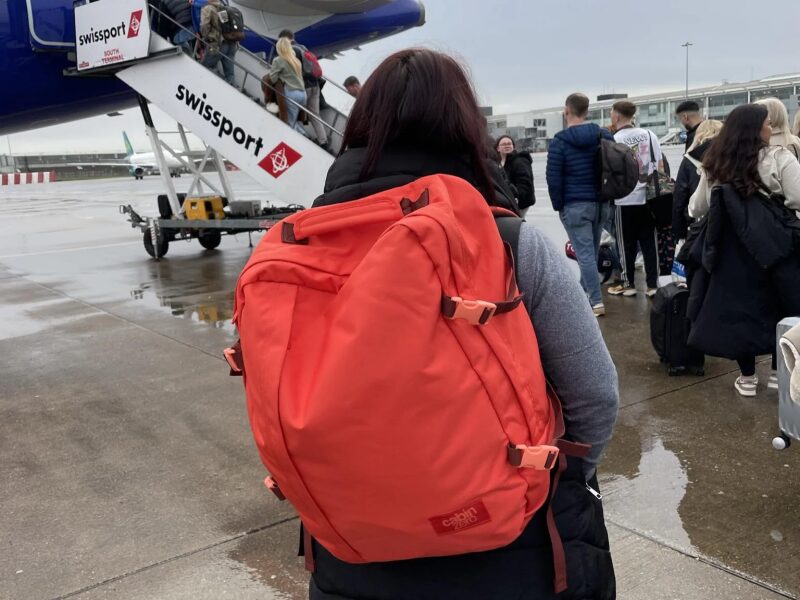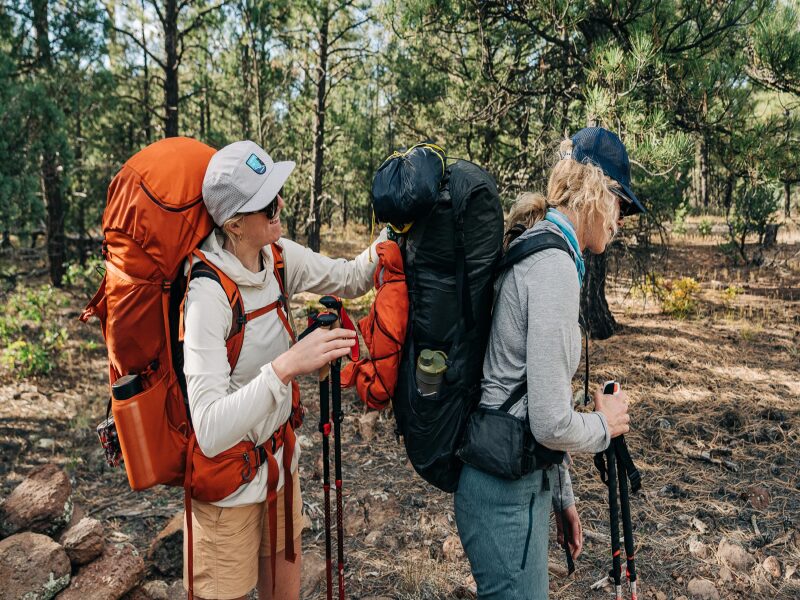Packing Light, Traveling Far: My Minimalist Approach to Shoulder Season Backpacking on a Budget (Experience)

Packing Light, Traveling Far: My Minimalist Approach to Shoulder Season Backpacking on a Budget (Experience)
Introduction – Shoulder Season Backpacking on a Budget
Backpacking has always held a special allure for me – the thrill of exploring new landscapes, immersing myself in diverse cultures, and embracing the freedom of the open road. Over the years, I’ve honed my backpacking skills, and one philosophy that has significantly enhanced my travel experiences is minimalist packing. There’s a unique charm to shoulder season travel – the sweet spot between peak and off-seasons – where you can enjoy pleasant weather, fewer crowds, and often, lower prices. However, backpacking during shoulder seasons, especially on a budget, presents its own set of challenges. This is where the minimalist approach shines, enabling you to pack light, travel far, and make the most of your adventures without breaking the bank. In this blog post, I’ll delve into my personal experiences and share valuable insights on how to embrace minimalist packing for shoulder season backpacking on a budget.
From essential gear recommendations to packing hacks and lessons learned along the way, I’ll equip you with the knowledge and inspiration to embark on your own unforgettable minimalist backpacking journey. Whether you’re a seasoned backpacker seeking to refine your packing strategy or a novice contemplating your first adventure, join me as we explore the art of packing light and traveling far, unlocking the true essence of shoulder season backpacking on a budget.

Why Minimalist Packing is Key for Budget Backpacking – Shoulder Season Backpacking on a Budget
When it comes to budget backpacking, minimalist packing isn’t just a preference; it’s a strategic advantage that can significantly impact your travel experience and your wallet. Let’s delve into why adopting a minimalist approach is crucial for those seeking to explore the world without breaking the bank.
Reduced Baggage Fees
Airlines have become increasingly stringent with baggage weight limits, and exceeding these limits can result in hefty fees. By packing light, you can avoid these extra costs and allocate your budget towards more enriching experiences during your trip. Remember, every penny saved on baggage fees can be used to indulge in local delicacies, visit unique attractions, or even extend your journey.
Easier Transportation
Lugging around a heavy backpack can be physically draining and limit your mobility, especially when navigating crowded airports, public transportation, or uneven terrain. Minimalist packing ensures that your backpack remains lightweight and manageable, allowing you to move freely and explore with ease. Imagine effortlessly hopping on and off trains, hiking to breathtaking viewpoints, or simply strolling through charming streets without the burden of a cumbersome load.
More Freedom and Flexibility
With fewer possessions to worry about, you gain a newfound sense of freedom and flexibility. You’re no longer tied down by your belongings, enabling you to embrace spontaneity and adapt to unexpected situations. Perhaps you stumble upon a hidden gem off the beaten path or decide to extend your stay in a captivating town. Minimalist packing empowers you to seize these opportunities without hesitation.
Less Stress and Worry
Losing or damaging belongings while traveling can be a major source of stress and anxiety. Minimalist packing minimizes this risk by reducing the number of items you carry. You can focus on enjoying your journey without constantly worrying about your possessions. Moreover, traveling with less stuff simplifies packing and unpacking, saving you precious time and energy.
Environmental Benefits
Minimalist packing aligns with sustainable travel practices by reducing consumption and waste. By packing only what you need, you minimize your environmental footprint and contribute to a more responsible and eco-conscious way of traveling. Embracing a minimalist mindset not only benefits your travel experience but also helps preserve the natural beauty of the destinations you explore.

My Essential Gear List for Shoulder Season Backpacking – Shoulder Season Backpacking on a Budget
Packing for shoulder season backpacking requires a thoughtful approach, as you need to be prepared for a range of weather conditions. However, with careful planning and a minimalist mindset, you can pack everything you need without overpacking. Here’s my essential gear list, curated through years of backpacking experience, to help you pack light and efficiently for your shoulder season adventures.
Clothing
- Base Layers: Opt for merino wool or synthetic fabrics that wick moisture and dry quickly. Pack a couple of long-sleeved shirts and leggings for cooler mornings and evenings.
- Mid Layers: A fleece jacket or insulated vest provides warmth without adding bulk. Pack a lightweight down jacket or synthetic puffy for colder temperatures.
- Outer Layers: A waterproof and breathable rain jacket is essential, even if rain isn’t in the forecast. Consider packing a pair of waterproof pants for added protection.
- Hiking Pants: Choose convertible pants that can transform into shorts for warmer days. Look for durable, quick-drying fabrics that offer flexibility and comfort.
- Hiking Shorts: Pack a pair of comfortable hiking shorts for warmer temperatures.
- T-Shirts: Pack a few lightweight, breathable t-shirts for layering and everyday wear.
- Underwear: Opt for moisture-wicking fabrics that dry quickly. Pack enough for a few days and plan to do laundry on the go.
- Socks: Choose hiking socks that provide cushioning and prevent blisters. Pack a few pairs and rotate them regularly.
- Hat and Gloves: Pack a warm hat and gloves for cooler temperatures, especially if you’ll be hiking at higher altitudes.
- Buff or Neck Gaiter: A versatile accessory that can be used as a scarf, headband, or face mask.
Footwear
- Hiking Boots or Shoes: Invest in a pair of comfortable, durable hiking boots or shoes that provide good ankle support and traction.
- Sandals or Flip-Flops: Pack a pair of lightweight sandals or flip-flops for relaxing at camp or wearing in showers.
Shelter
- Lightweight Tent: Choose a tent that is easy to set up and pack down, and offers adequate protection from the elements.
- Sleeping Bag: Select a sleeping bag that is rated for the temperatures you’ll encounter. Consider a down or synthetic fill for warmth and compressibility.
- Sleeping Pad: A sleeping pad provides insulation and comfort while sleeping on the ground. Choose a lightweight, inflatable pad for easy packing.
Cooking
- Compact Stove: A lightweight and efficient stove is essential for preparing meals on the go.
- Pot: Choose a pot that is large enough to cook meals for yourself or a small group.
- Utensils: A spork, knife, and small bowl or cup are all you need for basic meal preparation.
- Water Bottle: Pack a reusable water bottle and purify water from natural sources to reduce waste and save money.
Hygiene
- Travel-Sized Toiletries: Pack travel-sized shampoo, conditioner, soap, toothpaste, and toothbrush.
- Quick-Drying Towel: A microfiber towel dries quickly and takes up minimal space in your backpack.
- Hand Sanitizer: Hand Sanitizer: An important tool for staying clean while you’re on the go.
Other Essentials
- First-Aid Kit: Pack a basic first-aid kit with essentials like bandages, pain relievers, and antihistamines.
- Headlamp: A headlamp is crucial for navigating in the dark and performing tasks around camp.
- Multi-Tool: A multi-tool with a knife, pliers, and screwdriver can come in handy for various situations.
- Maps/Guidebook: Pack a map or guidebook for the area you’ll be exploring.
Remember, this is just a suggested list, and you may need to adjust it based on your specific needs and the destinations you’ll be visiting. The key is to pack light and prioritize multi-purpose items that can serve multiple functions. By focusing on essentials and embracing a minimalist mindset, you’ll be well-equipped for your shoulder season backpacking adventure without the burden of excess baggage.
Tips for Packing Light and Efficiently – Shoulder Season Backpacking on a Budget
Mastering the art of packing light and efficiently is a game-changer for any backpacker, especially when venturing out during shoulder seasons on a budget. Here are some tried-and-true tips to help you streamline your packing process and ensure you carry only what you need for a comfortable and fulfilling journey.
Plan Your Outfits in Advance
Before you start throwing things into your backpack, take the time to plan your outfits for each day of your trip. Consider the activities you’ll be doing and the expected weather conditions. This will help you avoid overpacking and ensure you have the right clothes for every situation.
- Layering is Key: Shoulder seasons can bring unpredictable weather, so layering is essential. Pack versatile pieces that can be mixed and matched to adapt to changing temperatures.
- Limit Your Options: Avoid packing multiple outfits for each day. Instead, choose a few key pieces that can be worn multiple times and easily washed if needed.
- Embrace Versatility: Look for clothing items that can serve multiple purposes. For example, a sarong can be used as a towel, scarf, or blanket.
- Consider Laundry Options: If you’ll have access to laundry facilities, pack fewer clothes and plan to wash them during your trip.
Roll Your Clothes Instead of Folding
Rolling your clothes instead of folding them can save valuable space in your backpack and help prevent wrinkles. It also makes it easier to see what you’ve packed without having to unpack everything.
Use Packing Cubes
Packing cubes are a backpacker’s best friend. They help keep your backpack organized and make it easy to find what you need without having to rummage through your entire bag. They also compress your clothes, saving even more space.
Choose Multi-Purpose Items
When packing light, every item should earn its place in your backpack. Look for multi-purpose items that can serve multiple functions. For example, a bandana can be used as a head covering, sweatband, or even a makeshift bandage.
Leave Room for Souvenirs
Don’t overpack your backpack. Leave some space for souvenirs or other items you might pick up along the way. You’ll be glad you did when you find that perfect memento or local treasure.
- Prioritize Experiences: Remember, the most valuable souvenirs are the memories you make, not the things you buy. Focus on creating unforgettable experiences rather than accumulating material possessions.
By implementing these packing tips, you’ll be well on your way to mastering the art of minimalist packing. Remember, the goal is to pack light and efficiently, allowing you to focus on the journey and the experiences that await you.

My Experience with Minimalist Backpacking: Lessons Learned – Shoulder Season Backpacking on a Budget
Over the years, I’ve embarked on numerous backpacking adventures, and with each trip, my commitment to minimalist packing has deepened. Through trial and error, I’ve discovered valuable lessons that have transformed my travel experiences. Let’s explore some of the key takeaways from my minimalist backpacking journeys.
The Benefits of Packing Light Far Outweigh Any Challenges
While minimalist packing may initially seem daunting, the benefits far outweigh any challenges you might encounter. The freedom of movement, reduced stress, and enhanced flexibility that come with carrying less are truly liberating. You’ll be amazed at how much more you can enjoy your trip when you’re not burdened by excess baggage.
It’s Okay to Make Mistakes and Adjust Your Packing List as You Go
No one is perfect, and even the most experienced minimalist packers make mistakes. Don’t be afraid to experiment and adjust your packing list as you go. If you find yourself carrying items you don’t need, consider donating or mailing them back home. Similarly, if you realize you’re missing something essential, don’t hesitate to purchase it along the way.
Don’t Be Afraid to Embrace Spontaneity and Let Go of Your Plans
Minimalist packing encourages spontaneity and adaptability. With fewer possessions tying you down, you’re free to embrace unexpected opportunities and detours. Let go of rigid plans and allow yourself to be guided by your curiosity and intuition. Some of the most memorable travel experiences happen when you step outside your comfort zone and embrace the unknown.
The Most Valuable Souvenirs are the Memories You Make, Not the Things You Buy
While it’s tempting to collect souvenirs from every destination you visit, remember that the most valuable souvenirs are the memories you create and the experiences you share. Focus on immersing yourself in the local culture, connecting with people, and savoring the moments. These intangible treasures will last a lifetime and enrich your life in ways that material possessions cannot.
Minimalist Backpacking is Not Just About Packing Less, It’s About Living More Intentionally
Minimalist backpacking is more than just a packing strategy; it’s a mindset that encourages intentional living and mindful consumption. By prioritizing experiences over possessions, you cultivate a deeper appreciation for the world around you and the journey itself. Minimalist backpacking invites you to simplify your life, focus on what truly matters, and discover the transformative power of travel.
Embracing Shoulder Season Travel: Why it’s the Best Time to Go – Shoulder Season Backpacking on a Budget
While peak seasons offer their own allure, shoulder seasons present a unique window of opportunity for budget backpackers seeking to maximize their travel experiences. Let’s explore why shoulder seasons are often considered the best time to embark on your backpacking adventures.
Lower Costs
One of the most compelling reasons to travel during shoulder seasons is the potential for significant cost savings. Flights, accommodations, and even activities tend to be cheaper during these periods, as demand is lower compared to peak seasons. This translates to more bang for your buck, allowing you to stretch your budget further and experience more for less.
Fewer Crowds
Shoulder seasons offer a respite from the overwhelming crowds that often characterize peak travel periods. Popular destinations become less congested, allowing you to enjoy a more peaceful and authentic experience. You’ll have more space to explore at your own pace, interact with locals, and truly immerse yourself in the local culture.
Pleasant Weather
Shoulder seasons often strike a balance between the extremes of peak seasons. You can expect mild temperatures and comfortable conditions for outdoor activities without the scorching heat or freezing cold that may accompany peak summer or winter travel. This makes shoulder seasons ideal for hiking, camping, and other adventures in nature.
Unique Experiences
Traveling during shoulder seasons offers the chance to witness the changing of the seasons and experience a destination in a different light. You might encounter vibrant fall foliage, blooming spring flowers, or the tranquility of a winter wonderland. Moreover, shoulder seasons often coincide with local festivals and events, providing a glimpse into the unique traditions and celebrations of a particular region.
By embracing shoulder season travel, you open yourself up to a world of possibilities, where you can experience the best of a destination without the crowds and inflated prices. It’s an opportunity to savor the beauty of the off-the-beaten-path moments and create lasting memories that will stay with you long after your journey ends.

Conclusion – Shoulder Season Backpacking on a Budget
As we’ve explored throughout this blog post, minimalist packing is a powerful tool for budget backpackers seeking to make the most of their shoulder season adventures. By carrying only the essentials and prioritizing experiences over possessions, you can unlock a world of freedom, flexibility, and unforgettable memories. Remember, the essence of minimalist backpacking lies not just in packing light but in embracing a mindset of intentional living and mindful consumption. It’s about focusing on what truly matters – the journey, the connections, and the transformative power of travel.
So, as you plan your next shoulder season backpacking trip, remember these key takeaways:
- Pack light and efficiently: Prioritize versatile, multi-purpose items and avoid overpacking.
- Embrace shoulder season travel: Enjoy lower costs, fewer crowds, pleasant weather, and unique experiences.
- Focus on experiences: Create lasting memories and prioritize personal growth over material possessions.
- Be adaptable and spontaneous: Let go of rigid plans and embrace the unexpected.
- Travel responsibly: Minimize your environmental impact and contribute to sustainable tourism practices.
By adopting a minimalist approach and embracing the spirit of adventure, you can embark on transformative journeys that enrich your life and leave a positive mark on the world. Remember, the journey is the destination, and with minimalist packing, you’ll be well-equipped to navigate the path with ease, grace, and a sense of wonder.
Call to Action – Shoulder Season Backpacking on a Budget
I’d love to hear about your own minimalist backpacking experiences and tips! In the comments below, share your thoughts and stories. Let’s inspire each other to travel lighter, farther, and more meaningfully.
Happy travels!
Recent Posts
Exploring the Unforgettable: What to Visit in Tasmania – 2025
Discovering the Must-See Gems: Exploring the Best Maldives Places to Visit – 2025
Is Visiting Bali Expensive? A Budget Breakdown for Your Dream Trip – 2025
Tags

United Kingdom
Quick booking process
+(94) 760709364



